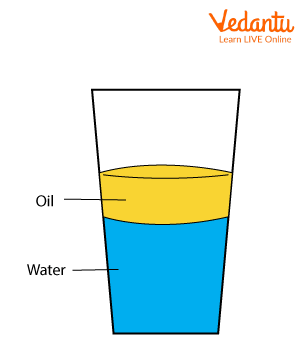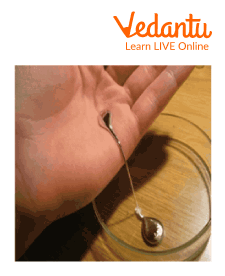




An Introduction to the States of Matter: Liquid Matter
Anything that has weight and takes space is called matter. The liquid is a state of matter that is neither hard like a solid nor as compressible as gas. But what is liquid in science? A liquid in science is anything that has a definite volume but no definite shape and conforms to the shape of the container that it is kept in.

States of Matter
What is Liquid?
The liquid is a state of matter made of small particles that are distant from each other. Let us see some pictures of liquid matter.

Particles in a Liquid
These particles are not arranged in a specific pattern, so they can move around and past each other. Liquids can be changed into solids and gases depending on temperature and pressure.
The process in which a solid turn into liquid is called melting.
The process in which a liquid turns into gas is called evaporation.
When a liquid turns into a solid, the process is called freezing.
When a gas turns into a liquid state, the process is called condensation.
Examples of Liquid
Some examples of liquids are as follows:
Water - Water is found all over the world, in oceans, seas, rivers, in the form of rain, etc.
Honey - Honey comes from bees and is found as a liquid in hives.

Honey
Blood - The blood in our body is also in the form of liquid.
Other examples of liquid are juice, milk, oil, etc.
Facts About Liquid State of Matter
Liquids don't have a proper shape. They take the shape of the containers they are kept in. Without a container, they form a pool or puddle.

Liquids Take the Shape of their Container
Some liquids do not mix. For example, oil and water, liquid wax and water.

Oil and Water do not Mix
Mercury is the only metal in the form of liquid at room temperature.

Mercury is a Liquid Metal
Dissolving is turning a solid into a liquid, like sugar in water.
Water, when frozen, turns into ice, which is solid. If water is boiled, it turns into vapour which is in a gaseous state.
A liquid can be weighed to find out how heavy it is.
Properties of Liquids
Liquids do not have a definite shape but take the shape of their containers.
Liquids can flow, and this ability is called viscosity.
Liquids have a fixed volume.
Liquids can be compressed under huge pressure.
Learning By Doing
Choose the correct answer
1. Liquids have a definite shape.
True
False
2. Which of the following things are liquid?
Book
Ballon
Chocolate syrup
None of the above.
3. Oils and water do not mix.
True
False
Solved Questions
1. Which metal is found in the form of liquid at room temperature?
Mercury
2. What is liquid?
Liquid is a state of matter. It does not have a definite shape. It has a definite volume. For example - water, milk, etc.
3. What is viscosity?
Liquids can flow, and this ability is called viscosity.
Summary
We have learnt some interesting information about liquids and other states of matter. The matter is everything that you can see, feel and touch around you. A liquid is a state of matter that has size or volume but does not have a shape. It can flow. It takes the shape of its container. Examples of liquid are water, milk, oil, juice, etc.
FAQs on Facts About Liquids for Kids to Know
1. What is a liquid? Can you give some simple examples?
A liquid is a state of matter that can flow, be poured, and takes the shape of any container it is put into. Unlike a solid, it doesn't have a fixed shape of its own. Some common examples you see every day are water, milk, juice, and oil.
2. What is the main difference between a solid and a liquid?
The biggest difference is their shape. A solid, like a pencil or a stone, keeps its own shape no matter where you put it. A liquid, like water, does not have a fixed shape and will always take the shape of the bottom of its container.
3. What are some fun and simple facts about liquids?
Here are a few interesting facts about liquids that are easy to remember:
- Liquids always flow downwards unless pushed by a force.
- When you heat a liquid like water, it can turn into a gas called steam or vapour. This is called evaporation.
- When you freeze a liquid, it turns into a solid. For example, water becomes ice.
- Some liquids are thick and flow slowly, like honey, while others are thin and flow quickly, like water.
4. Why do some liquids, like honey, flow much slower than water?
This is because of a property called viscosity, which is just a way of saying how thick a liquid is. Honey is very viscous (thick), so its tiny particles don't move past each other easily, making it flow slowly. Water is much less viscous (thinner), so it flows very fast.
5. How does a liquid like water turn into a gas?
When you heat water, its tiny particles get a lot of energy and start moving around very fast. When the water gets hot enough, the particles move so fast that they escape into the air as a gas called water vapour. This entire process is known as evaporation.
6. Can a gas turn back into a liquid?
Yes, it can! This process is called condensation. When a gas, like water vapour in the air, cools down, its particles lose energy and change back into liquid water. You can see this happen when tiny water droplets form on the outside of a cold glass on a warm day.
7. Do all liquids mix together perfectly?
No, not all liquids can mix. For example, if you try to mix oil and water, the oil will always float on top of the water in a separate layer. This is because their particles are different and they have different densities. Liquids that do mix, like milk and water, are called miscible.









